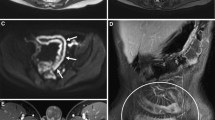Abstract
Background
Examinations using ionizing radiation are frequently used in the evaluation of disease activity in children affected by idiopathic inflammatory bowel disease (IBD).
Objective
To develop an MR imaging protocol without the need for fluoroscopic insertion of an enteral tube and to assess the disease activity in children with IBD.
Materials and methods
Included in the study were 37 children (22 girls and 15 boys; age range 7–15 years, mean 11.67 years) with IBD who underwent MR imaging of the small bowel. Of these 37 children, 32 had Crohn disease and 5 had indeterminate colitis. A water solution containing herbal fibres was administered orally or through a nasogastric tube. Patients were imaged on a 1.5-T MR scanner with T1-weighted and Τ2-weighted sequences followed by a dynamic study using 3-D T1-W images after intravenous administration of gadolinium.
Results
The percentage enhancement of the bowel wall was significantly increased in patients with abnormal C-reactive protein (CRP) values compared to patients with CRP values in the normal range (P<0.001). A relatively weak but significant correlation between percentage enhancement of the bowel wall and CRP values was noted during all phases of enhancement.
Conclusion
This MR imaging protocol is a safe and well-tolerated method for evaluating disease activity and extraintestinal manifestations of IBD in children.



Similar content being viewed by others
References
Umschaden HW, Szolar D, Gasser J et al (2000) Small-bowel disease: comparison of MR enteroclysis images with conventional enteroclysis and surgical findings. Radiology 215:717–725
Maglinte DD, Siegelman ES, Kelvin FM (2000) MR enteroclysis: the future of small-bowel imaging? Radiology 215:639–641
Wiarda BM, Kuipers EJ, Houdijk LP et al (2005) MR enteroclysis: imaging technique of choice in diagnosis of small bowel diseases. Dig Dis Sci 50:1036–1040
Shoenut JP, Semelka RC, Magro CM et al (1994) Comparison of magnetic resonance imaging and endoscopy in distinguishing the type and severity of inflammatory bowel disease. J Clin Gastroenterol 19:31–35
Korman U, Kurugoglu S, Ogut G (2005) Conventional enteroclysis with complementary MR enteroclysis: a combination of small bowel imaging. Abdom Imaging 30:564–575
Kettritz U, Isaacs K, Warshauer DM et al (1995) Crohn's disease. Pilot study comparing MRI of the abdomen with clinical evaluation. J Clin Gastroenterol 21:249–253
Gourtsoyiannis N, Papanikolaou N, Grammatikakis J et al (2004) Assessment of Crohn's disease activity in the small bowel with MR and conventional enteroclysis: preliminary results. Eur Radiol 14:1017–1024
Wiarda BM, Kuipers EJ, Heitbrink MA et al (2006) MR enteroclysis of inflammatory small-bowel diseases. AJR 187:522–531
Maccioni F, Viscido A, Broglia L et al (2000) Evaluation of Crohn disease activity with magnetic resonance imaging. Abdom Imaging 25:219–228
Schunk K, Kern A, Oberholzer K et al (2000) Hydro-MRI in Crohn's disease: appraisal of disease activity. Invest Radiol 35:431–437
Applegate KE, Maglinte DD (2008) Imaging of the bowel in children: new imaging techniques. Pediatr Radiol 38(Suppl 2):S272–S274
Magnano G, Granata C, Barabino A et al (2003) Polyethylene glycol and contrast-enhanced MRI of Crohn's disease in children: preliminary experience. Pediatr Radiol 33:385–391
Toma P, Granata C, Magnano G et al (2007) CT and MRI of paediatric Crohn disease. Pediatr Radiol 37:1083–1092
Laghi A, Borrelli O, Paolantonio P et al (2003) Contrast enhanced magnetic resonance imaging of the terminal ileum in children with Crohn's disease. Gut 52:393–397
Best WR, Becktel JM, Singleton JW et al (1976) Development of a Crohn's disease activity index. National Cooperative Crohn's Disease Study. Gastroenterology 70:439–444
Best WR, Becktel JM, Singleton JW (1979) Rederived values of the eight coefficients of the Crohn's Disease Activity Index (CDAI). Gastroenterology 77:843–846
Singleton JW (1987) Clinical activity assessment in inflammatory bowel disease. Dig Dis Sci 32:42S–45S
Shoenut JP, Semelka RC, Silverman R et al (1993) Magnetic resonance imaging in inflammatory bowel disease. J Clin Gastroenterol 17:73–78
Canani RB, de Horatio LT, Terrin G et al (2006) Combined use of noninvasive tests is useful in the initial diagnostic approach to a child with suspected inflammatory bowel disease. J Pediatr Gastroenterol Nutr 42:9–15
Gourtsoyiannis N, Papanikolaou N, Grammatikakis J et al (2002) MR enteroclysis: technical considerations and clinical applications. Eur Radiol 12:2651–2658
Gourtsoyiannis NC, Papanikolaou N (2005) Magnetic resonance enteroclysis. Semin Ultrasound CT MR 26:237–246
Schreyer AG, Seitz J, Feuerbach S et al (2004) Modern imaging using computer tomography and magnetic resonance imaging for inflammatory bowel disease (IBD) AU1. Inflamm Bowel Dis 10:45–54
Reittner P, Goritschnig T, Petritsch W et al (2002) Multiplanar spiral CT enterography in patients with Crohn's disease using a negative oral contrast material: initial results of a noninvasive imaging approach. Eur Radiol 12:2253–2257
Hiraishi K, Narabayashi I, Fujita O et al (1995) Blueberry juice: preliminary evaluation as an oral contrast agent in gastrointestinal MR imaging. Radiology 194:119–123
Lauenstein TC, Schneemann H, Vogt FM et al (2003) Optimization of oral contrast agents for MR imaging of the small bowel. Radiology 228:279–283
Low RN, Francis IR (1997) MR imaging of the gastrointestinal tract with i.v. gadolinium and diluted barium oral contrast media compared with unenhanced MR imaging and CT. AJR 169:1051–1059
Patak MA, Froehlich JM, von Weymarn C et al (2001) Non-invasive distension of the small bowel for magnetic-resonance imaging. Lancet 358:987–988
Rubin DL, Muller HH, Young SW (1992) Formulation of radiographically detectable gastrointestinal contrast agents for magnetic resonance imaging: effects of a barium sulfate additive on MR contrast agent effectiveness. Magn Reson Med 23:154–165
Author information
Authors and Affiliations
Corresponding author
Rights and permissions
About this article
Cite this article
Alexopoulou, E., Roma, E., Loggitsi, D. et al. Magnetic resonance imaging of the small bowel in children with idiopathic inflammatory bowel disease: evaluation of disease activity. Pediatr Radiol 39, 791–797 (2009). https://doi.org/10.1007/s00247-009-1272-z
Received:
Revised:
Accepted:
Published:
Issue Date:
DOI: https://doi.org/10.1007/s00247-009-1272-z




